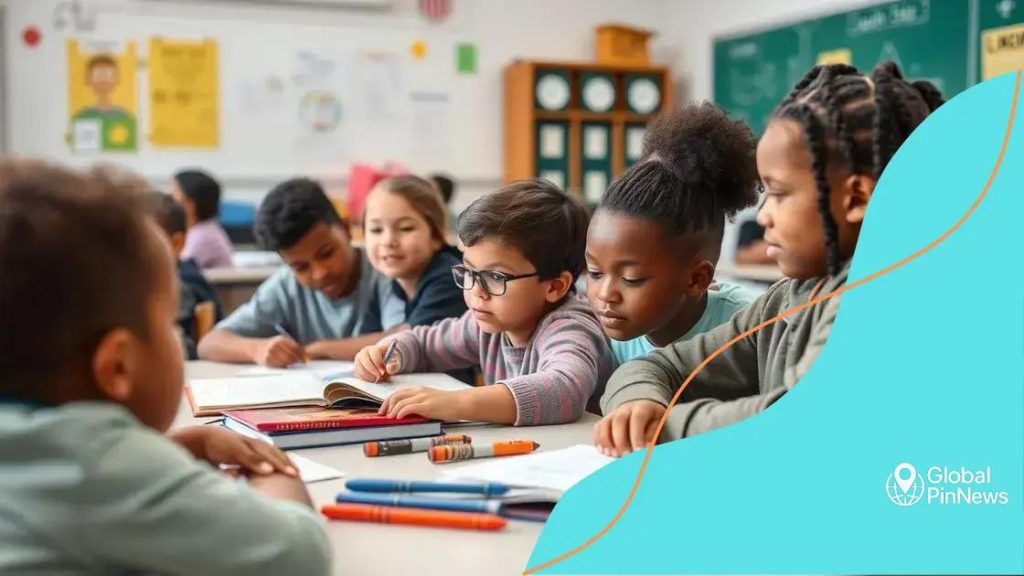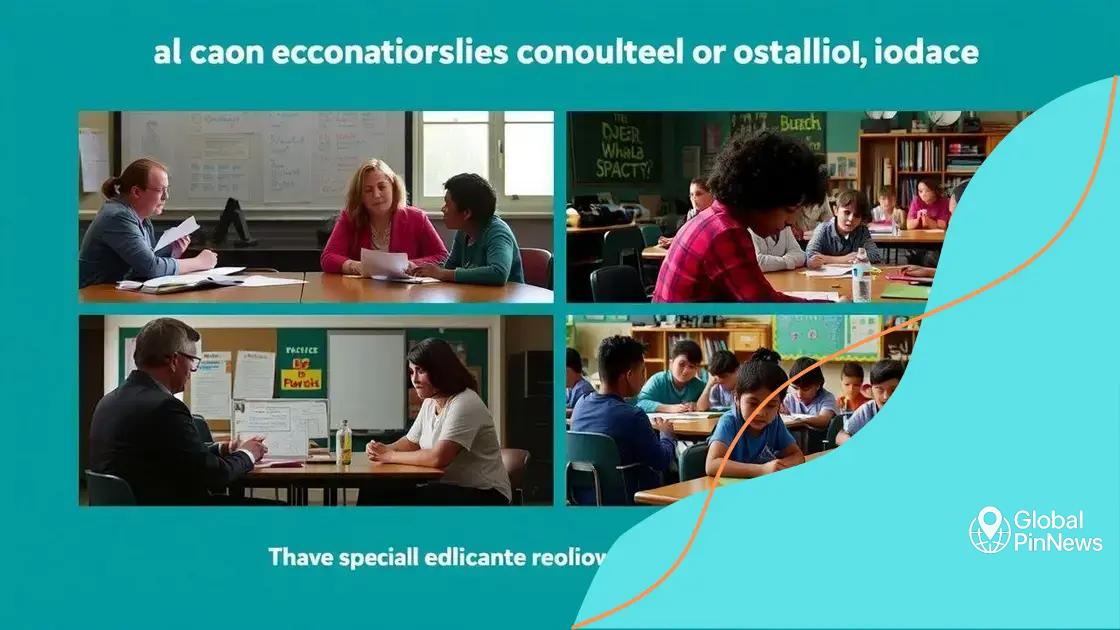Special education resource allocation explained in detail

Effective special education resource allocation enhances academic performance, increases student engagement, and supports social skills development by ensuring that resources are tailored to meet the diverse needs of students.
Special education resource allocation is essential for creating equitable learning environments. Have you ever wondered how schools decide where to invest their resources? Let’s dive into this critical topic!
Understanding special education resource allocation
Understanding special education resource allocation is vital for providing tailored support to students with unique needs. It involves how schools distribute their financial, physical, and human resources to foster a conducive learning environment.
Key Factors in Resource Allocation
Several key factors influence how resources are allocated in special education. These factors include funding levels, student needs, and educational policies. Knowing these elements helps to comprehend the overall system.
- Funding levels greatly impact available resources.
- Individual student assessments determine specific needs.
- Policies shape how resources must be managed.
Effective allocation is not just about having resources; it’s about meeting the specific demands of students. A well-designed system can improve educational outcomes dramatically. Furthermore, stakeholder involvement is crucial. Teachers, administrators, and parents should collaborate to identify the needs of students.
Challenges in Allocation
Despite the importance of resource allocation, schools face various challenges. These include limited budgets and inconsistent policy enforcement, which can result in disparities in support. Overcoming these challenges requires proactive measures and continuous evaluation of resource use.
- Budget constraints often limit adequate provision.
- Inconsistent policy application can lead to inequity.
- Regular evaluations help ensure resources meet current needs.
In conclusion, understanding special education resource allocation is essential for educators and policymakers. By focusing on the key factors and addressing challenges, stakeholders can create a more equitable education system for all students.
Key components of resource allocation
Understanding the key components of resource allocation is critical for effective special education. It ensures that resources are aptly assigned to meet varying student needs. By recognizing these components, schools can create a more supportive learning environment.
Financial Resources
Financial resources form the backbone of resource allocation. These funds are crucial for hiring qualified staff and purchasing necessary materials. When budgets are well-managed, schools can provide better support to students with special needs.
- Funding sources include local, state, and federal programs.
- Budget allocation should prioritize high-need areas.
- Regular audits help ensure funds are used efficiently.
The allocation of financial resources directly impacts how well special education programs function. A well-funded program can hire specialists who understand student requirements. It also allows for enrichment programs that enhance learning.
Human Resources
The hiring of qualified professionals is another vital component. Staff trained in special education are essential for addressing various learning challenges. They can create tailored educational plans that fit each student’s unique abilities.
- Special Education Teachers: They specialize in instructing students with disabilities.
- Support Staff: Includes aides who assist teachers and students directly.
- Consultants: Experts who help develop best practices in the classroom.
In addition to teachers, supportive staff such as counselors and therapists play a key role in resource allocation. Their involvement ensures that students not only learn but also feel supported emotionally.
Physical Resources
Physical resources include the facilities and materials necessary for effective learning. Classrooms should be adapted to accommodate students with disabilities. This can mean having accessible furniture, technology, and adaptive tools.
- Adaptive technologies: Tools that aid in learning for students with disabilities.
- Safe and accessible facilities: Essential for inclusive education.
- Learning materials: Books, equipment, and resources tailored to different needs.
Having appropriate physical resources allows for a more inclusive setting, where all students can thrive. It removes barriers and makes learning accessible to everyone.
Challenges in allocating resources for special education

Challenges in allocating resources for special education can significantly impact student success. Identifying these challenges is essential for improving educational outcomes. Limited budgets and varying policies often create obstacles that schools must navigate.
Budget Constraints
One of the primary challenges is financial limitations. Many schools operate on tight budgets, making it difficult to allocate sufficient funds for special education programs. This can lead to inadequate staff and insufficient resources for students. When schools cannot provide what is necessary, it directly affects the quality of education.
- Funding often depends on local tax revenues.
- Unstable state and federal funding can cause uncertainty.
- Emergency funds are rarely available for special needs.
Without a stable financial foundation, special education services can suffer. It is crucial for schools to seek alternative funding sources and advocate for increased budgets to meet their students’ needs.
Policy Inconsistencies
Another challenge involves inconsistencies in policies governing resource allocation. Education policies can vary widely from one district to another. This inconsistency can lead to unequal access to resources for students with disabilities.
- Some districts may prioritize special education more than others.
- Policy changes can disrupt existing resource plans.
- Compliance with federal and state laws can be overly complex.
When policies are not uniformly applied, students can end up receiving unequal support. This inequity ultimately hinders their educational progress. Clear communication and collaboration among all levels of education policy are essential for creating a more equitable environment.
Lack of Trained Personnel
A further challenge is the shortage of trained personnel in special education. Many educators lack the necessary training to address diverse learning needs. Without qualified staff, schools struggle to implement effective programs.
- Continuous professional development is often lacking.
- High turnover rates create instability in special education staffing.
- Competing demands make it hard for teachers to specialize.
Investing in ongoing training and professional development is vital for equipping educators with the skills necessary for helping students succeed. Schools must prioritize hiring qualified individuals who can effectively meet the needs of each student.
Strategies for effective resource management
Implementing effective strategies for resource management in special education can lead to improved outcomes for students. These strategies focus on optimizing the use of available resources, ensuring that every student receives the support they need.
Regular Assessment of Needs
Conducting regular assessments of student needs is essential for effective resource management. By understanding the specific challenges students face, schools can tailor their resources to meet these demands. This not only ensures that resources are used wisely but also enhances student support.
- Individualized Education Plans (IEPs) help identify specific needs.
- Frequent feedback from teachers and parents can guide adjustments.
- Monitoring progress allows for timely changes to resource allocation.
Assessing needs regularly keeps schools informed about changing requirements. It also empowers educators to utilize their resources more effectively, creating a flexible learning environment for all students.
Collaboration Among Stakeholders
Collaboration among stakeholders is another key strategy. When schools, families, and community organizations work together, they can pool their resources. This collaborative approach can enhance educational support for students with special needs.
- Building partnerships with community organizations can provide additional resources.
- Parents can offer valuable insights into their children’s needs.
- Teachers and specialists can collaborate to share strategies and resources.
Effective collaboration leads to a more comprehensive support system. It encourages involvement and commitment from all parties, creating a united front in helping students succeed.
Training and Development for Staff
Investing in training and professional development for staff is crucial in managing resources effectively. Educators equipped with the right skills can better meet student needs. Continuous training ensures that teachers are up to date on best practices and innovative strategies.
- Workshops and training sessions can enhance teaching methods.
- Fostering a culture of learning keeps staff engaged and informed.
- Mentorship programs can support new teachers in their roles.
When educators feel supported and valued, they are more likely to create successful learning environments. This translates to better outcomes for students with special needs.
Impact of resource allocation on student outcomes
The impact of resource allocation on student outcomes is significant and multifaceted. Proper allocation of resources can enhance academic performance and overall well-being for students with special needs. It plays a critical role in shaping their educational experiences.
Improved Academic Performance
When resources are allocated effectively, students often show marked improvements in their academic performance. This includes access to specialized teaching methods, materials, and technology tailored to their needs. When students have the correct support, their ability to engage with the curriculum increases.
- Personalized learning approaches cater to individual learning styles.
- Access to advanced technology can enhance learning experiences.
- Smaller class sizes allow for more individualized attention.
By meeting the specific needs of students, schools can significantly boost achievement levels. This targeted support helps students gain confidence and encourages them to excel.
Increased Engagement and Motivation
Resource allocation also contributes to increased student engagement and motivation. When students feel supported and valued, they are more likely to participate actively in class. Providing access to resources that resonate with students’ interests enhances their connection to learning.
- Interactive tools can make learning fun and engaging.
- Adequate resources foster a positive learning environment.
- Opportunities for collaboration improve social skills and motivation.
Engaged students are more likely to attend school regularly, participate in extracurricular activities, and develop a love for learning. This engagement helps to improve their emotional well-being, creating a positive feedback loop that bolsters academic success.
Social Skills Development
Effective resource management also promotes the development of social skills among students. Access to collaborative projects and group activities can enhance interpersonal skills. This social aspect is crucial for students, especially those in special education.
- Group activities help students learn teamwork.
- Social interactions can reduce feelings of isolation.
- Communication skills are enhanced through peer collaboration.
When schools allocate resources that encourage teamwork and collaboration, students develop the social skills necessary for success outside the classroom. These skills are critical for their future interactions in both academic and professional settings.
FAQ – Questions about Special Education Resource Allocation
How does resource allocation impact student performance?
Effective resource allocation provides tailored support, which can enhance students’ academic performance and overall success in school.
What role does collaboration play in resource management?
Collaboration among educators, families, and community members ensures that resources are effectively used to meet the diverse needs of students.
Why is continuous assessment of needs important?
Regular assessments help identify individual student requirements, allowing for timely adjustments in resource allocation that optimize support.
How can schools increase student engagement?
By allocating resources that resonate with students’ interests and providing interactive tools, schools can enhance student engagement and motivation.
